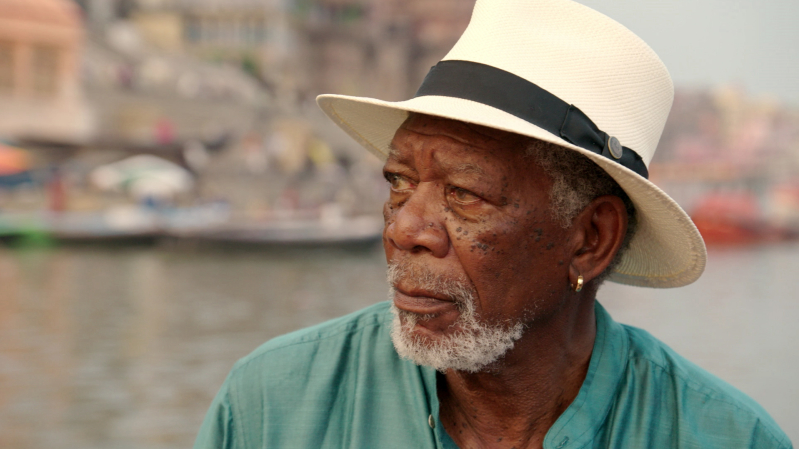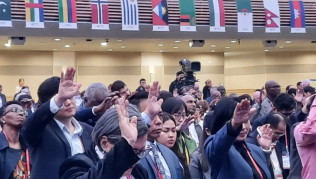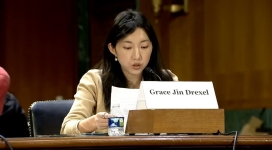
Growing up as a child in Mississippi, Morgan Freeman encountered racism, and viewed it as being a confusing evil thing. In the fifth episode of National Geographic Channel's The Story of God, Freeman explores the concept of evil. Why does it exist? Where does it come from? Freeman says, "For Christianity, it could be the devil himself, or is evil something that comes from inside of us?"
"For all of our capacity to do good, the urge to do evil has plagued human history. If you believe in a world under divine control, why should evil even exist at all?
Where does it come from? Some faiths see it as an unseen force that pervades the entire earth."
Neuroscientist Kent Kiehl tries to get inside the brains of psychopathic killers. Freeman is introduced to a notorious criminal who has raped more than two dozen women and murdered three. His identity is hidden to avoid given him the added publicity and notoriety. When asked why he did these things, he said that he wasn't able to stop himself from acting on impulsive behaviors. He says that he doesn't feel emotions like everyone else. He doesn't feel remorse.
This man has been diagnosed with Psychopathic Personality Disorder. Dr. Kiehl has studied 800 psychopathic criminals, and has had their brains scanned. The orbital frontal cortex is the area of the brain that controls these impulse behaviors, and this particular criminal is said to have a rare 1 in a million brain that would cause him to do these things. Freeman wonders if even though he has faulty wiring in his brain, if he truly has a choice about whether or not to commit these crimes. He says that psychopathic criminals are at the extreme of human behavior, but we all face the choice to do good or evil. For thousands of years we've battled those urges.
In Luxor, Egypt, he sees the oldest depictions of the struggle to choose to do good or evil. He views the tombs of the nobles , specifically the tomb of Menna, where they view 3,500 year old artwork on the walls. There is a scene where Menna is being judged on the good and evil works in front of the god, Osiris. In the picture his heart is in balance.
Freeman suggests that the idea of eternal award for turning one's back on evil spread through Egyptian society, and may have been the start of the theology in Judaism, Christianity and Islam. He says that the idea of the fear of consequences being the only thing that keeps people on a righteous path makes him wonder, "Are we inherently good, or inherently evil."
The Christian ideology of "original sin" brings him to sit down to discuss with a Baptist reverend and theologian, who explains original sin as a primal desire that we all have, a basic human urge or impulse. The Baptist pastor seems to explain the criminal's tendencies as a demonic possession. He also says that we can have a satanic influence in our own desire to steer away from what God wants.
Whether they are living or dead, Freeman explores how our ancestors have an influence.
He travels to India to find out what Hindus believe is the source of evil- the unhappy souls of their ancestors. At a Hindu temple where exorcisms happen all day long. He learns about a goblin, Pishosh who was purified by Shivah and cures him of his disease. In return, he is asked to help others by protecting people by the pond from other evil spirits. The statue of this goblin sits at the temple, where the pond full of "brackish" water is believed to heal people who feel their lives are haunted by an evil presence. Hindus believe that when someone's death is traumatic or unhappy, their soul can become angry and haunt the lives of their children or other relatives. This can cause mental and physical illness or even financial troubles. The rituals performed at the temple can free people of these hauntings.
The Shaman prays in tongues, and releases the person . Some people even cook meals for their dead ancestors and give them no shoes and things their ancestors might need for their journey. The food is poured into the pond, and a coin nailed to a holy tree.
In Hinduism, there is no dichotomy between good and evil, and even evil is treated respectfully and with care- that evil can be purified. Evil is thought of as a spirit that needs help, or needs to find peace. Freeman thinks that is "cool."
A trip to California explores the religion of Zoroastrianism. This religion believes in a good god(Ahura Mazda) and a devil-like figure(Angra Mainyu). The religion began 3,500 years ago in ancient Iran. A symbol of Zoroastrianism is an ever burning fire. There are two principles good an evil. Good thoughts/good words/and good deeds. To defeat evil in the world, there will be cataclysmic battle. The Israelites didn't believe in the devil until Jewish people ran into the Zoroastrianism beliefs and assimilated those beliefs into their own. Modern Zoroastrianism does not believe in a literal devil/Satan, but more of an internal battle of good and evil. God is resident in each of us. Our problems are caused by man and must be solved by man, and not blamed upon a supernatural force. Good and evil exist within us all, and we must make the choice to do the right thing. Purging the world of evil is not the work of messiahs, leaders, or other entities, but each person has the work to do.
We then travel to New Zealand, where a researcher is studying whether children will follow rules with and without the idea of an invisible princess watching them. The study showed that children are more apt to follow the rules if they think they are being watched- the idea behind this study being that maybe humans need some higher power to believe in order to be good?
There is a very brief segment where Buddhism is touched on during travel to Sarnath, India. "Buddhists believe that the urge to do evil stems from ignorance about how our minds work."
Freeman meets a former Nazi skinhead who turned his life around after accepting his salvation with Jesus Christ. Morgan Freeman tells him that he represents the hope of the world. "Evil can be contained. This hope is at the core of the Christian faith."
The episode concludes with baptism, and talks about the act celebrating the death, burial and resurrection of Jesus Christ.
"Evil is an interesting thing," said Freeman. "On one hand, it can create havoc and cause pain and sadness, and yet, would things like mercy and forgiveness exist without it?"
What did you think of this episode? If you would like to study more, there are articles and extra clips on the National Geographic Channel webpage. The final episode of the Story of God will explore the subject of miracles on Sunday May 8th at 9/8C. Make sure to tune in, and join in on the discussion!







